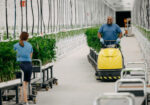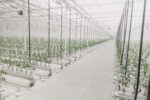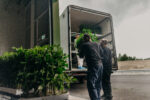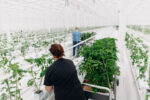In countries like Sweden, where the growing season has always been dictated by harsh winters, the idea of harvesting fresh produce year-round has long seemed impossible. But now, with greenhouses heated with industrial waste heat, every day can be a harvest day—no matter the weather, the season, or the time of year.
Big challenges bring big opportunities. And our current food system presents us with one of the most ingenious challenges of our time: feeding more people with fewer resources. The food system is also a major contributor to climate related problems. It is responsible for nearly 30% of global greenhouse gas emissions, depletes freshwater reserves, and accelerates biodiversity loss. Furthermore, ethical concerns regarding labour conditions in agriculture persist, particularly in regions that supply large portions of Europe’s food. With the world’s population expected to exceed nine billion by 2050, and food demand projected to rise by 50% to 70%, the need for innovative, sustainable food production methods has never been more urgent.
At WA3RM, we choose to see this as a great opportunity. Instead of being bound by the limitations of the past, we now have the chance to create a food system that is not only more resilient but also more efficient, sustainable, and just.

Currently, much of Europe, including the Nordic countries, relies on imports from regions increasingly affected by climate change, such as Southern Spain and Morocco. These areas face rising water scarcity and extreme weather events, which threaten food supply stability and leads to increased consumer prices in the end. Additionally, increasing geopolitical uncertainty—ranging from trade conflicts to war—further underscores the need for greater regional self-sufficiency.
Extreme weather events such as droughts, heatwaves, and floods have already begun to impact key crops like rice, soy, and cocoa (IPCC, 2023). Recent droughts in West Africa and the Mediterranean have led to record-high prices for cocoa and olive oil (Financial Times, 2024). Meanwhile, flooding has devastated regions like Valencia and Andalusia, key hubs for Spain’s citrus and vegetable production. These events not only threaten Spain’s own agricultural output but also disrupt food availability across Europe, where Spain is one of the largest exporters of fresh produce.
In this new volatile landscape, the Nordics have a unique opportunity to bolster food security and economic resilience by increasing domestic food production.

Today, only 30% of the vegetables consumed in Sweden is produced locally. Greenhouses heated with industrial waste heat can change that – fast.
Resilience Against Supply Chain Disruptions and Geopolitical Risks
Geopolitical tensions, pandemics, and climate-related disasters have repeatedly disrupted global food supply chains, leading to food shortages and price volatility. The war in Ukraine, for instance, demonstrated how quickly such shocks can ripple through global markets. A shift towards regional food production using waste heat would mitigate these risks, ensuring a stable food supply even during crises and reducing dependence on politically unstable regions for essential food imports.
Water Scarcity: Agriculture accounts for 70% of global freshwater use, placing immense pressure on water supplies, particularly in drought-prone regions. Hydroponic greenhouses, which recirculate water, use significantly less water than traditional farming methods. Studies indicate that hydroponic lettuce production can save up to 230 liters of water per kilogram compared to conventional soil-based farming.
Avoided emission: Heating greenhouses with fossil fuels is carbon-intensive, yet many large-scale greenhouse operations still rely on gas or oil. By utilizing industrial waste heat, emissions can be avoided reduced, making year-round food local production feasible without using fossil fuels.
Land Use and Biodiversity: Traditional agriculture has driven extensive deforestation and habitat destruction, with 77% of agricultural land currently dedicated to livestock farming, which contributes only 18% of global calorie supply. Greenhouses require significantly less land, allowing for high-yield production in compact spaces without expanding agriculture into fragile ecosystems.
Scandinavia’s Untapped Agricultural Potential
Traditionally, the cold Nordic climate has been seen as a barrier to large-scale vegetable production. However, with abundant industrial waste heat from sectors such as paper mills, steel production, and data centers, the Nordics have the potential to become a powerhouse for sustainable food production. By redirecting excess heat to modern, hydroponic greenhouses, countries like Sweden, Norway, and Finland could drastically increase their domestic vegetable output, reducing reliance on imports while decreasing the environmental footprint related to food.
Already, successful projects have demonstrated that using industrial waste heat can boost local year-round food production in Sweden. Greenhouses heated this way contributes to increased self-sufficiency, less water-use and transports and, creates new jobs. If scaled up, this approach could transform Scandinavia into a major supplier or even exporter of fresh produce, much like Southern Europe today.
Traditionally, the cold Nordic climate has been seen as a barrier to large-scale vegetable production. However, with abundant industrial waste heat from sectors such as paper mills, steel production, and data centers, the Nordics have the potential to become a powerhouse for sustainable food production. By redirecting excess heat to modern, hydroponic greenhouses, countries like Sweden, Norway, and Finland could drastically increase their domestic vegetable output, reducing reliance on imports while decreasing the environmental footprint of food transportation.
Already, successful pilot projects have demonstrated that using industrial waste heat can lower both heating costs and emissions. Greenhouses heated in this way require significantly less energy than traditional fossil-fuel-based heating, making them both environmentally and economically attractive. If scaled up, this approach could transform Scandinavia into a major supplier of fresh produce, much like Southern Europe today.

Regenergy Frövi reuses waste heat from a carton factory to produce 64 000 000 tomatoes every year.
The industrial sector's excess heat is an untapped resource that can, if leveraged correctly, create new circular business models, reduce waste, and strengthen food security.
The transition to large-scale greenhouse agriculture in the Nordics is not just an environmental necessity; it is also an economic opportunity. The agrifood sector represents 12% of global GDP, and investments in sustainable food production are projected to yield high returns. Industrial symbiosis—where waste from one industry becomes a resource for another—aligns with European Union policies promoting circular economies and climate neutrality.
However, scaling up this solution requires policy support, investment incentives, and streamlined permitting processes. Policymakers must prioritize infrastructure development, facilitate partnerships between industry and agriculture, and provide financial incentives for businesses adopting circular economy principles. Additionally, retail commitments to sourcing and marketing local, sustainably grown produce will be crucial in driving demand. And more consumers must be willing to look at their purchasing behaviour and increasingly favour locally produced goods.
For investors and decision-makers eager to drive rapid positive change, this presents a clear business case: scalable, high-impact investments that combine profitability with sustainability. It offers a promising solution to one of the greatest challenges of our time: feeding more people with using less land, water, and energy. Humanity must produce more food in the next four decades than we have in the last 8,000 years of agriculture combined (WWF).
Greenhouses heated with industrial waste heat have the potential to revolutionize food production in Scandinavia. The Nordics can take a leading role in building a resilient food system. Turning the North into the new South, demonstrating that innovation, sustainability, and collaboration can transform challenges into opportunities. The question is how quickly industries, governments, and investors can come together to make it a reality.
Beyond improving food security and self-sufficiency, greenhouse agriculture using industrial waste heat directly addresses some of the most pressing challenges in food production.
01. Resilience Against supply chain disruptions
Geopolitical tensions, pandemics, and climate-related disasters have repeatedly disrupted global food supply chains, leading to food shortages and price volatility. The war in Ukraine, for instance, demonstrated how quickly such shocks can ripple through global markets. A shift towards regional food production using waste heat would mitigate these risks, ensuring a stable food supply even during crises and reducing dependence on politically unstable regions for essential food imports.
02. Water scarcity
Agriculture accounts for 70% of global freshwater use, placing immense pressure on water supplies, particularly in drought-prone regions. Hydroponic greenhouses, which recirculate water, use around 10x less water than traditional farming methods.
03. Avoided emissions
Heating greenhouses with fossil fuels is carbon-intensive, yet many large-scale greenhouse operations still rely on gas or oil. By utilizing industrial waste heat, emissions can avoide, making year-round food production feasible in a more responsible manner.
04. Land Use and Biodiversity
Traditional agriculture has driven extensive deforestation and habitat destruction, with 77% of agricultural land currently dedicated to livestock farming, which contributes only 18% of global calorie supply. Greenhouses require significantly less land, allowing for high-yield production in compact spaces without expanding agriculture into fragile ecosystems.

Our Projects
Conflict and climate change pressure the food system. Greenhouses heated with industrial waste heat can boost vegetable production in Sweden and other parts of the northern world.
BIO3 is working to shape a responsible, circular food system that makes smarter use of natural resources, land, and energy—while advancing fish welfare, climate goals, and global food security.
Sources: Aquafeed, Frontiers in Marine Science, Nofima, FAO
Sources: Aquafeed, Frontiers in Marine Science, Nofima, FAO
75 %
estimated food demand rise by 2050
1/3
of global CO2-emissions comes from food production
50 %




